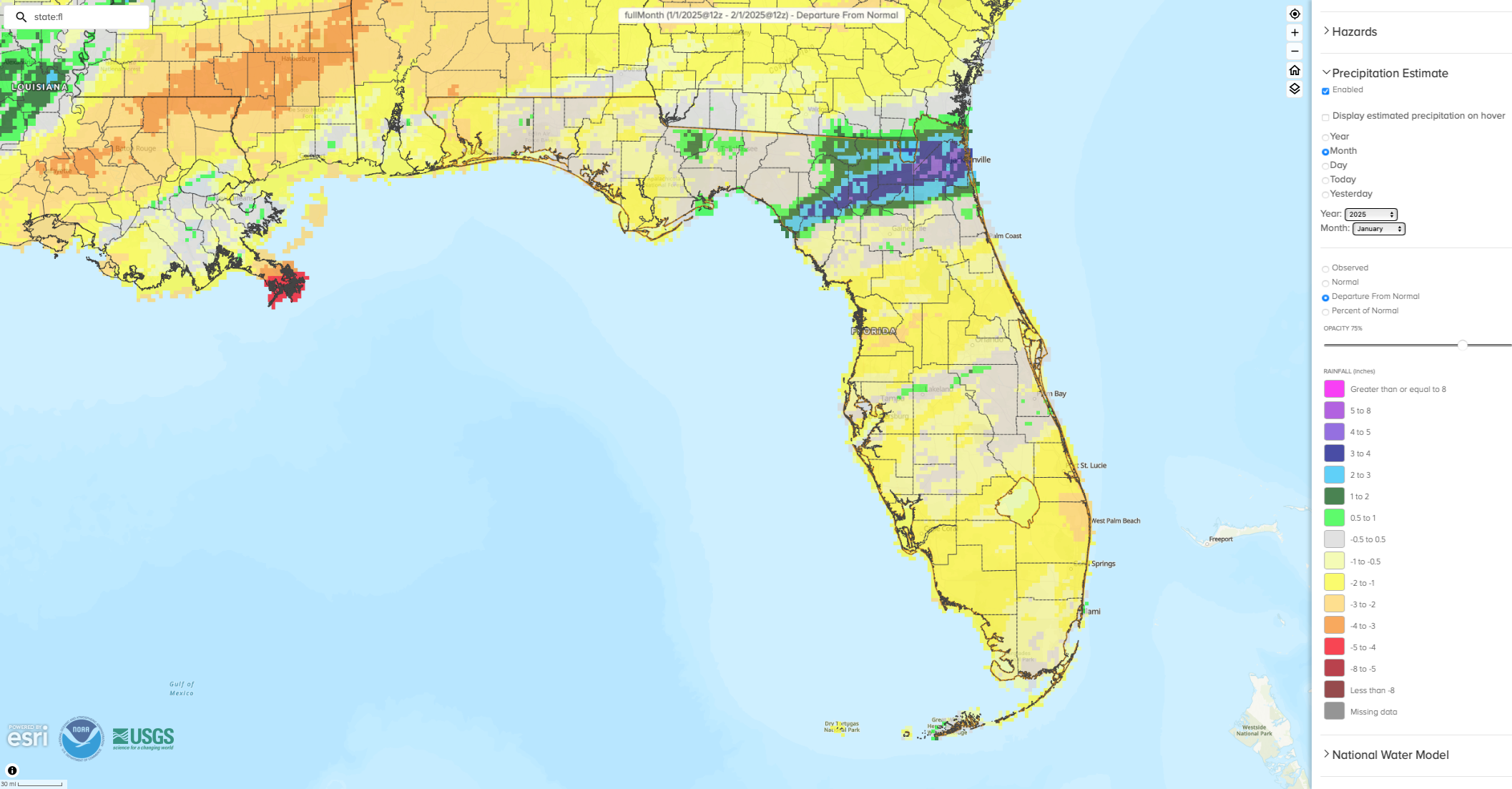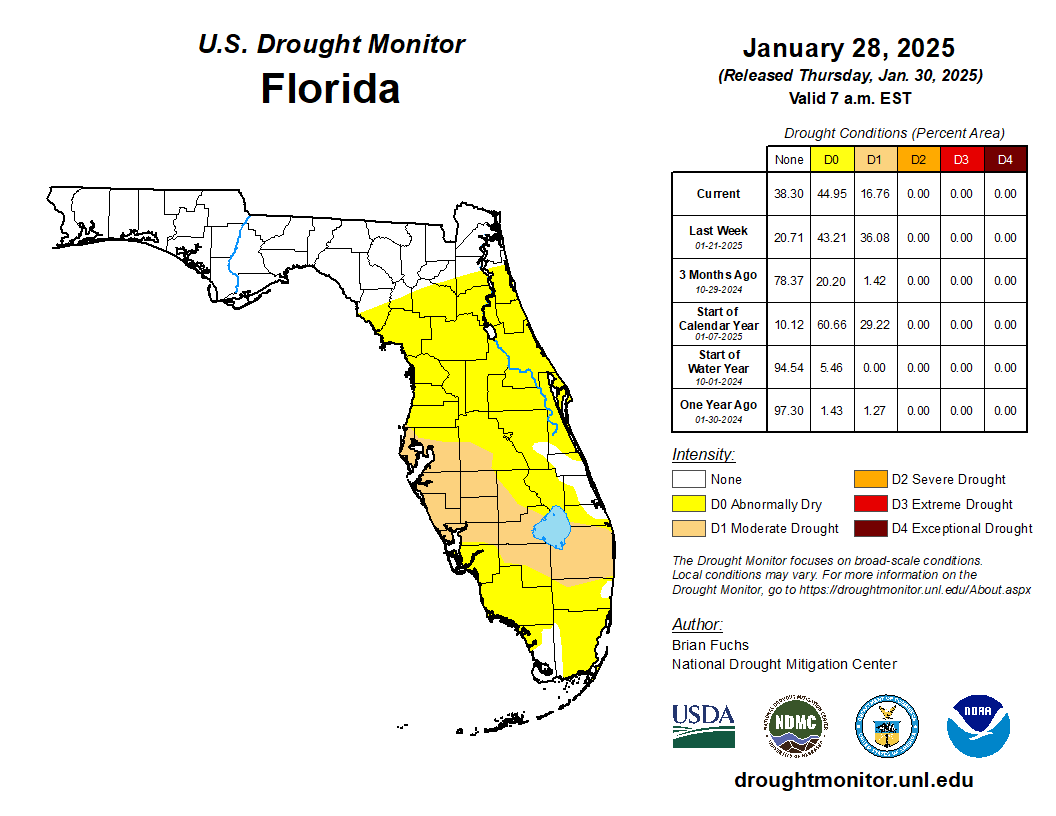Prepared by Florida Climate Center
The Florida State University
Tallahassee, FL
Summary:
- Average monthly temperatures in January were well below normal in Florida.
- Monthly precipitation totals were generally below to near normal in January, except for parts of Northeast Florida which were above normal. On January 21-22, historic snowfall and a wintry mix of snow, sleet, and freezing rain affected the Panhandle and northern Florida.
- By the end of January, approximately 17% of the state was in moderate drought (D1) and 45% was abnormally dry (D0), according to the U.S. Drought Monitor.
- La Niña conditions emerged in the tropical equatorial Pacific Ocean during December 2024 and are expected to persist through February-April (59% chance) before transitioning to ENSO-neutral likely during March-May 2025 (60% chance).
Average monthly temperatures in January were well below normal across Florida. Average monthly temperature departures from normal ranged from -6.1 ̊F in Gainesville to -1.9 ̊F in Miami for the month (see Table 1 and Appendix 1 for select cities). A cold Arctic outbreak affected much of the state during the week of January 20, stretching as far south as Naples in Southwest Florida. Southeast Florida missed out on the worst of the cold but also experienced below average temperatures. Gainesville tied for its coldest January on record, with a monthly average temperature of 48.7 ̊F, which ties with 2003. The lowest temperatures of the month arrived on January 22-23 in the western Panhandle, when the minimum temperature departures from normal were ranged from -24 ̊F to -31 ̊F below normal. Warming occurred during the last few days of the month, with mean temperatures rebounding to well above normal. Select daily low maximum temperature records tied or broken during the month are provided in Appendix 2.
Table 1. January average temperatures and departures from normal ( ̊F) for selected cities.
| Station | Mean Temperature | Departure from Normal |
| Pensacola | 47.7 | -5.5 |
| Tallahassee | 47.1 | -5.1 |
| Jacksonville | 48.4 | -5.8 |
| Orlando | 56.6 | -4.0 |
| Tampa | 57.3 | -4.7 |
| Miami | 66.7 | -1.9 |
| Key West | 68.3 | -2.3 |
Monthly precipitation totals were generally below to near normal in January, except for parts of Northeast Florida which were above normal. The monthly precipitation departures from normal ranged from -0.94 inches in Miami to +3.32 inches in Jacksonville (see Table 2 and Appendix 1 for select locations). On January 21-22, a wintry mix of snow, sleet, and freezing rain fell across the Florida Panhandle and northern Florida with the highest accumulations of snowfall occurring in the western and northern parts of the Panhandle. The highest snowfall totals reported are between 9” and 10” mostly in the western Panhandle counties in and north of Pensacola. These totals rival the current state snowfall record of 4.0” in Milton, Fla. set on March 6, 1954. Locations further east around Tallahassee received a mix of sleet and snow, and places along the coast like Apalachicola saw freezing rain. Additional snowfall measurements observed during this event are provided in Appendix 3.
Table 2. January precipitation totals and departures from normal (inches) for selected cities.
| Station | Total Rainfall | Departure from Normal | Total Snowfall |
| Pensacola | 5.45 | +0.42 | 8.9 |
| Tallahassee | 4.49 | +0.08 | 1.9 |
| Jacksonville | 6.60 | +3.32 | 0.1 |
| Orlando | 1.57 | -0.91 | NA |
| Tampa | 3.17 | +0.52 | NA |
| Miami | 0.89 | -0.94 | NA |
| Key West | 1.79 | -0.04 | NA |
Figure 1. A graphical depiction of the monthly rainfall departure from normal (inches) for January (courtesy of NOAA, NWS).

La Niña Advisory.
La Niña conditions emerged in December 2024 in the tropical equatorial Pacific Ocean. La Niña conditions are expected to persist through February-April 2025 (59% chance) and transition to ENSO-neutral during March-May 2025 (60% chance). Since this La Niña developed relatively late in the season, temperatures in our region have been driven more by other weather and climate patterns, including a series of cold fronts and a strong polar vortex that led to well below normal temperatures in January. While this La Niña is expected to be a weak event, it can still exert its influence on our weather and climate over the next few months, which typically call for warmer and drier conditions during winter in Florida.
Hazardous Weather Events in January.
According to the Local Storm Reports issued by the local National Weather Service offices serving Florida, there were 240 individual local reports of hazardous weather events recorded across the state during the month of January (see Table 3 for a breakdown by event type). Many local storm reports of snow and wintry precipitation were submitted during the historic snowstorm. One injury was reported in Nassau County on the 22nd due to a car accident on I-95 due to icy road conditions. The historic snowstorm shut down portions of I-10 in the Panhandle and closed schools across the region for several days as thawing of snow and ice occurred slowly as the cold temperatures lingered.
Table 3. Breakdown of storm reports submitted in Florida during the month of January (compiled from Iowa State University/Iowa Environmental Mesonet).
| Report Type | Number of Reports |
| Heavy Rain | 22 |
| Hail | 3 |
| Marine Thunderstorm Wind | 4 |
| Non-Thunderstorm Wind Gust | 18 |
| Non-Thunderstorm Wind Damage | 0 |
| Tornado/Waterspout/Funnel Cloud | 0/0/0 |
| Thunderstorm Wind Damage | 8 |
| Thunderstorm Wind Gust | 23 |
| Snow | 154 |
| Sleet | 6 |
| Freezing Rain | 2 |
Daily Record Events in January.
Table 4. Summary of daily records broken or set in Florida in January (source: NCEI Daily Weather Records).
| Category | Number of Records |
| Highest daily max. temp. | 1 |
| Highest daily min. temp. | 1 |
| Lowest daily max. temp. | 58 |
| Lowest daily min. temp. | 14 |
| Highest daily precipitation | 16 |
| Total | 90 |
Drought-Related Impacts.
Drought improved in the Panhandle but moderate drought affected parts of the Peninsula during the month. In mid-January, about 26% of the state was in moderate drought (D1) and roughly 56% of the state was abnormally dry (D0), according to the U.S. Drought Monitor. By the end of the month, moderate drought (D1) affected about 17% of the state and 45% of the state remained abnormally dry (D0) (Figure 2 below).
As of January 31, the Lake Okeechobee water level was 14.41 ft. above sea level (Feet-NGVD29), which is below average for this time of year. At the first of the month, the water level was 15.12 ft. above sea level.
Figure 3. A graphical depiction of the latest drought conditions in Florida according to the U.S. Drought Monitor (courtesy of the National Drought Mitigation Center, University of Nebraska-Lincoln).

Agriculture-Related Impacts.
The cold temperatures and wintry precipitation in January led to problems with some crops. Snow delayed field work for some producers, and numerous reports of crop damage were made, such as for strawberries, leafy greens, citrus, and others. Snow and ice damaged some trees and blueberry bushes in northern Florida. Pasture conditions were mostly fair but did decline with the freezing temperatures and snow. As temperatures warmed near the end of the month, pasture conditions began to improve. Cattle conditions were mostly good throughout the month. Sugarcane planting and harvest progressed well, and producers have started to prepare for rice planting. For more information, consult the Crop Progress State Stories, which is published by the USDA’s National Agricultural Statistics Service December through March.
Appendix 1
Additional January departures from normal data for select Florida locations (Source: NWS).
| Station | Average Temperature (˚F) | Departure from Normal (˚F) | Total Rainfall (in.) | Departure from Normal (in.) |
| Gainesville | 48.7 | -6.1 | 2.50 | -0.79 |
| Sarasota | 59.1 | -3.3 | 1.08 | -1.71 |
| Melbourne | 57.4 | -4.3 | 1.59 | -1.04 |
| Fort Myers | 61.5 | -3.2 | 0.52 | -1.89 |
| West Palm Beach | 64.3 | -2.0 | 0.94 | -2.53 |
Appendix 2
Select daily record low maximum temperatures (°F) tied or broken during January 2025 (compiled from NOAA).
| Location | Date | Record | Broken/Tied | Last |
| Fort Lauderdale | 8 | 59 | Broken | 63 in 2006 |
| Lake City | 21 | 42 | Broken | 43 in 1984 |
| Marianna | 21 | 38 | Broken | 45 in 2024 |
| Apalachicola | 22 | 38 | Broken | 43 in 1940 |
| Bradenton | 22 | 46 | Broken | 52 in 1984 |
| Ocala | 22 | 42 | Broken | 50 in 1985 |
| Tampa | 22 | 46 | Tied | 46 in 1985 |
| Pensacola | 22 | 37 | Broken | 45 in 1966 |
| Orlando | 22 | 47 | Broken | 48 in 1985 |
| Gainesville | 22 | 38 | Broken | 46 in 2022 |
| Tampa | 22 | 46 | Broken | 49 in 1985 |
| Crestview | 22 | 37 | Broken | 50 in 2014 |
| Jacksonville | 22 | 34 | Broken | 41 in 2022 |
| Tallahassee | 22 | 42 | Broken | 44 in 2022 |
| Bradenton | 23 | 47 | Broken | 49 in 1985 |
| Clermont | 23 | 44 | Broken | 50 in 1960 |
| Daytona Beach | 23 | 50 | Broken | 55 in 1961 |
| Deland | 23 | 44 | Broken | 53 in 2014 |
| Hastings | 23 | 40 | Broken | 46 in 2022 |
| Hialeah | 23 | 59 | Broken | 61 in 1960 |
| Kissimmee | 23 | 46 | Broken | 54 in 1960 |
| Niceville | 23 | 38 | Broken | 46 in 1966 |
| Orlando | 23 | 49 | Broken | 50 in 1960 |
| Tampa | 23 | 49 | Broken | 52 in 1960 |
| Clermont | 24 | 46 | Broken | 50 in 2016 |
Appendix 3
Select preliminary snowfall totals, in inches, from 7:00 am EST January 21 through 9:00 am EST January 22, compiled from the Weather Prediction Center and National Weather Service offices.
| Station | Total Snowfall (in) |
| 1 NE Ferry Pass. | 10.0 |
| Milton | 9.8 |
| Pace | 9.0 |
| Pensacola Intl AP | 8.9 |
| Bellview 1 W | 8.0 |
| Pensacola Beach | 7.5 |
| Crestview | 9.0 |
| Bonifay | 6.0 |
| Defuniak Springs | 4.75 |


